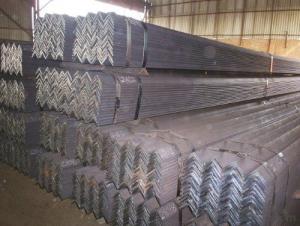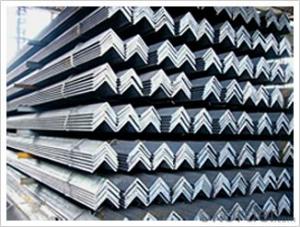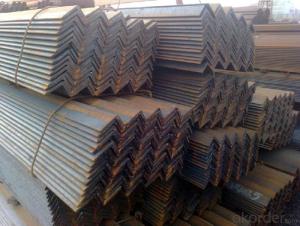Angel steel for construction about JIS SS400
- Loading Port:
- Tianjin
- Payment Terms:
- TT OR LC
- Min Order Qty:
- 25 m.t.
- Supply Capability:
- 10000 m.t./month
OKorder Service Pledge
OKorder Financial Service
You Might Also Like
Product Description:
Angle Steel Details:
| Minimum Order Quantity: | 25mts | Unit: | m.t. | Loading Port: | China Main Port |
| Supply Ability: | 80000-100000MTS/YEAR | Payment Terms: | TT or LC |
Product Description:
Specifications of JIS SS400 Angle Steel
1.Standards:GB,ASTM,BS,AISI,DIN,JIS
2.Invoicing on theoretical weight or actual weight as customer request
3.Material: JIS G3192,SS400;SS540.
4. Payment terms:
1).100% irrevocable L/C at sight.
2).30% T/T prepaid and the balance against the copy of B/L.
3).30% T/T prepaid and the balance against L/C
5.Sizes:

EQUAL ANGLES SIZES |
| ||
a(mm) | a1(mm) | thickness(mm) | length |
25 | 25 | 2.5---3.0 | 6M/12M |
30 | 30 | 2.5---4.0 | 6M/12M |
38 | 38 | 2.5 | 6M/12M |
38 | 38 | 3.0---5.0 | 6M/12M |
40 | 40 | 3.0---6.0 | 6M/12M |
50 | 50 | 3 | 6M/12M |
50 | 50 | 3.7---6.0 | 6M/9M/12M |
60 | 60 | 5.0---6.0 | 6M/9M/12M |
63 | 63 | 6.0---8.0 | 6M/9M/12M |
65 | 65 | 5.0---8.0 | 6M/9M/12M |
70 | 70 | 6.0---7.0 | 6M/9M/12M |
75 | 75 | 5.0---10.0 | 6M/9M/12M |
80 | 80 | 6.0---10.0 | 6M/9M/12M |
90 | 90 | 6.0---10.0 | 6M/9M/12M |
100 | 100 | 6.0---12.0 | 6M/9M/12M |
120 | 120 | 8.0-12.0 | 6M/9M/12M |
125 | 125 | 8.0---12.0 | 6M/9M/12M |
130 | 130 | 9.0-12.0 | 6M/9M/12M |
140 | 140 | 10.0-16.0 | 6M/9M/12M |
150 | 150 | 10---15 | 6M/9M/12M |
160 | 160 | 10---16 | 6M/9M/12M |
180 | 180 | 12---18 | 6M/9M/12M |
200 | 200 | 14---20 | 6M/9M/12M |
5. Material Specifications:
Grade | Yield Strength,N/mm² | Extension Strength N/mm² | |||
Thickness of Steel,mm | |||||
≦16 | >16-≦40 | >40-≦100 | >100 | ||
SS330 | ≧205 | ≧195 | ≧175 | ≧165 | 330-430 |
SS400 | ≧245 | ≧235 | ≧215 | ≧205 | 400-510 |
SS490 | ≧285 | ≧275 | ≧255 | ≧245 | 490-610 |
SS540 | ≧400 | ≧390 | - | - | ≧540 |
Usage & Applications Angle Steel
Trusses;
Transmission towers;
Telecommunication towers;
Bracing for general structures;
Stiffeners in structural use.
Packaging & Delivery of Angle Steel
1. Transportation: the goods are delivered by truck from mill to loading port, the maximum quantity can be loaded is around 40MTs by each truck. If the order quantity cannot reach the full truck loaded, the transportation cost per ton will be little higher than full load.
2. With bundles and load in 20 feet/40 feet container, or by bulk cargo, also we could do as customer's request.
3. Marks:
Color mark: There will be color marking on both end of the bundle for the cargo delivered by bulk vessel. That makes it easily to distinguish at the destination port.
Tag mark: There will be tag mark tied up on the bundles. The information usually including supplier logo and name, product name, made in China, shipping marks and other information request by the customer.
If loading by container the marking is not needed, but we will prepare it as customer request.
Production flow of Angle Steel
Material prepare (billet) —heat up—rough rolling—precision rolling—cooling—packing—storage and transportation
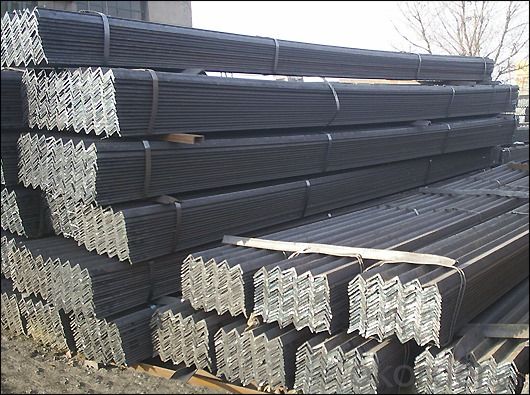
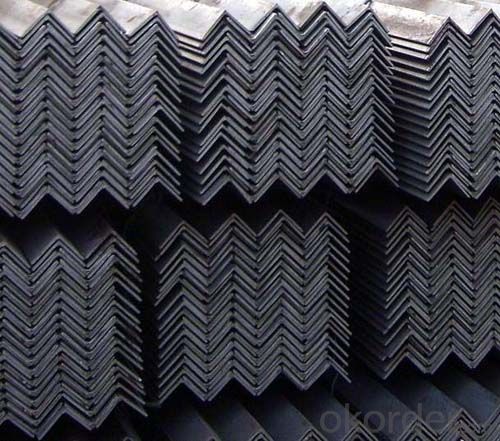
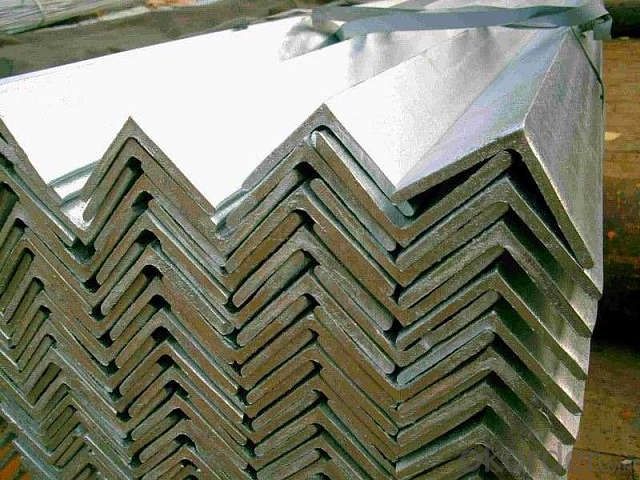
- Q:What is the typical length of a steel angle?
- Steel angles can have varying lengths depending on their purpose and application. Generally, a steel angle is commonly found at a length of 20 feet or 6 meters. This standard length facilitates convenient handling, transportation, and installation in diverse construction and fabrication projects. Nevertheless, it is important to acknowledge that steel angles can be tailored or trimmed to shorter lengths in order to meet specific requirements or accommodate specific designs.
- Q:How do you determine the required number of fasteners for a steel angle connection?
- To determine the required number of fasteners for a steel angle connection, several factors need to be considered. These include the load being applied, the size and thickness of the angle, the type and strength of the fasteners being used, and any applicable building codes or engineering standards. Typically, calculations or guidelines provided by structural engineers or industry standards are used to determine the minimum number and spacing of fasteners needed to ensure the connection is strong and safe.
- Q:Can galvanized square tubes and angle iron be welded together?
- Yes, if the requirement is not high, it can be welded directly. If the requirement is high, the zinc coating on the galvanized square pipe can be polished off before welding, and then welded. However, two kinds of welding methods, welding well, must be carried out at the weld corrosion. Now there is a special coating for hot-dip galvanizing on the market. It is characterized by high zinc content and 96% zinc content. It can provide similar anticorrosive effect to hot-dip galvanizing for repairing parts.
- Q:What are the different types of steel angles used in transmission line towers?
- There are typically three types of steel angles used in transmission line towers: equal leg angles, unequal leg angles, and back-to-back angles. Equal leg angles have equal dimensions on both sides, while unequal leg angles have different dimensions on each side. Back-to-back angles consist of two equal leg angles joined back-to-back to form a single unit. These different types of angles allow for flexibility and strength in designing and constructing transmission line towers.
- Q:What is the maximum span for a steel angle beam?
- The maximum span for a steel angle beam depends on various factors such as the load it is intended to support, the dimensions of the beam, and the type of steel being used. It is best to consult engineering tables, codes, or a structural engineer to determine the maximum span for a specific steel angle beam in a given application.
- Q:How do you calculate the load distribution on a steel angle?
- To calculate the load distribution on a steel angle, you need to consider the applied load, the geometry of the angle, and its material properties. First, determine the magnitude and direction of the applied load. Then, analyze the angle's dimensions, such as length, width, and thickness, to determine its section properties. Using principles of mechanics and structural engineering, you can calculate the internal forces acting on the angle, such as bending moments and shear forces. These internal forces can be used to determine the load distribution along the angle, considering factors like stress concentrations and load transfer between different sections of the angle. Various mathematical equations and structural analysis techniques, such as beam theory or finite element analysis, can be employed to accurately calculate the load distribution on a steel angle.
- Q:How do you determine the appropriate length of a steel angle for a specific application?
- To determine the appropriate length of a steel angle for a specific application, you typically need to consider the dimensions and requirements of the project. This involves assessing factors such as the desired angle, the load and weight it will be subjected to, the structural support needed, and any specific design or building codes that must be adhered to. Consulting engineering and construction guidelines, performing calculations, and seeking professional advice can help ensure the correct length of steel angle is determined for the application.
- Q:How do you determine the deflection of a steel angle?
- To determine the deflection of a steel angle, you need to consider various factors such as the applied load, the moment of inertia of the angle, the length of the span, and the modulus of elasticity of the steel. By utilizing the appropriate formulas and equations for deflection, such as the Euler-Bernoulli beam theory, you can calculate the deflection of the steel angle under the given load and conditions.
- Q:What are the different corrosion protection methods for steel angles?
- There are several different corrosion protection methods available for steel angles, depending on the specific application and environmental conditions. Some of the most common methods include: 1. Galvanization: This involves coating the steel angles with a layer of zinc, which provides excellent corrosion resistance. The zinc layer acts as a sacrificial anode, corroding instead of the underlying steel. 2. Paint coatings: Applying a high-quality paint coating to the steel angles can provide effective corrosion protection. The paint acts as a barrier, preventing moisture and corrosive substances from reaching the steel surface. 3. Powder coating: Similar to paint coatings, powder coating involves applying a dry powder to the steel angles and then baking it to create a durable and corrosion-resistant finish. 4. Epoxy coatings: Epoxy coatings are commonly used for steel angles that will be exposed to harsh environments or aggressive chemicals. These coatings provide excellent adhesion and resistance to corrosion. 5. Cathodic protection: This method involves using a sacrificial anode or impressed current to protect the steel angles from corrosion. The anode corrodes instead of the steel, providing long-term protection. 6. Barrier coatings: Barrier coatings, such as polyethylene or PVC wraps, provide a physical barrier between the steel angles and the surrounding environment, preventing moisture and corrosive substances from reaching the surface. 7. Hot-dip galvanizing: In this method, the steel angles are immersed in a bath of molten zinc, creating a thick layer of zinc coating that offers excellent corrosion protection. It is important to consider the specific requirements of the application when choosing a corrosion protection method for steel angles. Factors such as the environment, expected service life, and budget should be taken into account to ensure the most suitable protection method is selected.
- Q:What is the typical width of a steel angle?
- The typical width of a steel angle can vary depending on its intended use and the specific requirements of the project. However, in general, steel angles are available in a wide range of sizes and dimensions. Commonly, the width of a steel angle can range from 1 inch to 8 inches or more. It is important to consult the relevant industry standards and specifications to determine the appropriate width for a specific application.
1. Manufacturer Overview |
|
|---|---|
| Location | |
| Year Established | |
| Annual Output Value | |
| Main Markets | |
| Company Certifications | |
2. Manufacturer Certificates |
|
|---|---|
| a) Certification Name | |
| Range | |
| Reference | |
| Validity Period | |
3. Manufacturer Capability |
|
|---|---|
| a)Trade Capacity | |
| Nearest Port | |
| Export Percentage | |
| No.of Employees in Trade Department | |
| Language Spoken: | |
| b)Factory Information | |
| Factory Size: | |
| No. of Production Lines | |
| Contract Manufacturing | |
| Product Price Range | |
Send your message to us
Angel steel for construction about JIS SS400
- Loading Port:
- Tianjin
- Payment Terms:
- TT OR LC
- Min Order Qty:
- 25 m.t.
- Supply Capability:
- 10000 m.t./month
OKorder Service Pledge
OKorder Financial Service
Similar products
New products
Hot products
Related keywords
